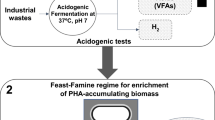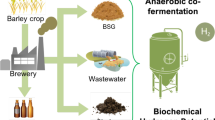Abstract
Olive mill wastewater (OMW) generated during olive oil extraction presents a significant challenge for olive growers due to its pollution potential, high organic and mineral contents, and acidic nature. Anaerobic digestion has emerged as an efficient method to tackle this challenge and valorize this waste, as it offers ecological and energetic benefits by converting pollutants into biogas—chiefly methane, a renewable energy source. This study investigated the inhibition kinetics of two substrates—glucose and milled olive wastewater—by evaluating a group of C1–C4 organic acids in salt form, including formic (C1), acetic (C2), propionic (C3), lactic (C3), pyruvic (C3), and butyric (C4) acids. Batch experimental tests were conducted to assess the impacts of these fatty acids acting as intermediates in anaerobic organic degradation. Each acid was individually used as a substrate in fermentation, with concentrations ranging from 1000 mg chemical oxygen demand (COD)/L to 5000 mg COD/L under mesophilic conditions (37 °C). The kinetic parameters were estimated using the Andrews and Monod equations. The results showed that formate exhibited self-substrate inhibition in anaerobic degradation, with the maximum specific growth rate observed at 3000 mg COD/L for glucose and 2000 mg COD/L for OMW. The inhibition constants were 4900 mg COD/L (glucose) and 2500 mg COD/L (OMW). Similarly, propionate evinced auto-inhibition when glucose was used as a substrate at concentrations above 2000 mg COD/L. However, acetate, lactate, pyruvate, and butyrate did not inhibit methane production, even at the highest concentrations tested (5000 mg COD/L).
Graphical abstract









Similar content being viewed by others
Availability of data and materials
All data generated or analyzed during this study are included in this published article.
References
Ahring BK, Westermann P (1988) Product inhibition of butyrate metabolism by acetate and hydrogen in a thermophilic coculture. Appl Environ Microbiol 54:2393–2397. https://doi.org/10.1128/aem.54.10.2393-2397.1988
Akdemir EO, Ozer A (2009) Investigation of two ultrafiltration membranes for treatment of olive oil mill wastewater. Desalination 249:660–666. https://doi.org/10.1016/j.desal.2008.06.035
Amani T, Nosrati M, Sreekrishnan TR (2010) Anaerobic digestion from the viewpoint of microbiological, chemical, and operational aspects: a review. Environ Rev 18:255–278. https://doi.org/10.1139/A10-011
AuxiliadoraLópez R, Tena M, Solera R, Pérez M (2023) Anaerobic co-digestion of sewage sludge and wine vinasse mixtures in single-stage and sequential-temperature processes. Fuel 348:128531. https://doi.org/10.1016/j.fuel.2023.128531
Battista F, Strazzera G, Valentino F et al (2022) New insights in food waste, sewage sludge and green waste anaerobic fermentation for short-chain volatile fatty acids production: a review. J Environ Chem Eng 10:108319. https://doi.org/10.1016/j.jece.2022.108319
Bermúdez-Penabad N, Kennes C, Veiga MC (2017) Anaerobic digestion of tuna waste for the production of volatile fatty acids. Waste Manag 68:96–102. https://doi.org/10.1016/j.wasman.2017.06.010
Boone DR, Johnson RL, Liu Y (1989) Diffusion of the interspecies electron carriers H2 and formate in methanogenic ecosystems and its implications in the measurement of Km for H2 or formate uptake. Appl Environ Microbiol 55:1735–1741. https://doi.org/10.1128/aem.55.7.1735-1741.1989
Boutafda A, Hafidi M, Ouhdouch Y et al (2023) Fungal strain as biological tool to remove genotoxicity effect of phenolic compounds from olive mill wastewater. Sustainability 15:6510. https://doi.org/10.3390/su15086510
Buswell AM, Mueller HF (1952) Mechanism of methane fermentation. Ind Eng Chem 44:550–552. https://doi.org/10.1021/ie50507a033
Chai A, Wong Y-S, Ong S-A et al (2021) Haldane–Andrews substrate inhibition kinetics for pilot scale thermophilic anaerobic degradation of sugarcane vinasse. Bioresour Technol 336:125319. https://doi.org/10.1016/j.biortech.2021.125319
Chatzisymeon E, Foteinis S, Mantzavinos D, Tsoutsos T (2013) Life cycle assessment of advanced oxidation processes for olive mill wastewater treatment. J Clean Prod 54:229–234. https://doi.org/10.1016/j.jclepro.2013.05.013
Clodoveo ML, Yangui A, Fendri M et al (2021) Protected geographical indications for EVOO in Tunisia: towards environmental, social, and economic sustainable development. Sustain. https://doi.org/10.3390/su132011201
Díaz I, Fdz-Polanco F, Mutsvene B, Fdz-Polanco M (2020) Effect of operating pressure on direct biomethane production from carbon dioxide and exogenous hydrogen in the anaerobic digestion of sewage sludge. Appl Energy 280:115915. https://doi.org/10.1016/j.apenergy.2020.115915
Emembolu L, Nwabanne J, Onu E, Obiakor I (2017) Simulation of kinetic model for anaerobic digestion of pharmaceutical wastewater. Chem Sci Int J 20:1–13. https://doi.org/10.9734/csji/2017/34050
Enzmann F, Mayer F, Rother M, Holtmann D (2018) Methanogens: biochemical background and biotechnological applications. AMB Express 8:1. https://doi.org/10.1186/s13568-017-0531-x
Fang H, Li C, Zhang T (2006) Acidophilic biohydrogen production from rice slurry. Int J Hydrog Energy 31:683–692. https://doi.org/10.1016/j.ijhydene.2005.07.005
Fang W, Ye J, Zhang P et al (2017) Solid-state anaerobic fermentation of spent mushroom compost for volatile fatty acids production by pH regulation. Int J Hydrog Energy 42:18295–18300. https://doi.org/10.1016/j.ijhydene.2017.04.148
Fuess LT, Lens PNL, Garcia ML, Zaiat M (2022) Exploring potentials for bioresource and bioenergy recovery from vinasse, the “new” protagonist in Brazilian sugarcane biorefineries. Biomass 2:374–411. https://doi.org/10.3390/biomass2040025
Fukuzaki S, Nishio N, Shobayashi M, Nagai S (1990) Inhibition of the fermentation of propionate to methane by hydrogen, acetate, and propionate. Appl Environ Microbiol 56:719–723. https://doi.org/10.1128/aem.56.3.719-723.1990
Guyot JP, Brauman A (1986) Methane production from formate by syntrophic association of Methanobacterium bryantii and Desulfovibrio vulgaris JJ. Appl Environ Microbiol 52:1436–1437. https://doi.org/10.1128/aem.52.6.1436-1437.1986
Hatem Ksibi AZ (2015) Numerical optimization of biogas production through a 3-steps model of anaerobic digestion: sensitivity of biokinetic constants values. J Bioremed Biodegrad. https://doi.org/10.4172/2155-6199.1000302
Haybrard J, Simon N, Danel C et al (2017) Factors generating glucose degradation products in sterile glucose solutions for infusion: statistical relevance determination of their impacts. Sci Rep 7:11932. https://doi.org/10.1038/s41598-017-12296-5
Haydari I, Aziz K, Kaya S et al (2023) Green synthesis of reduced graphene oxide and their use on column adsorption of phenol from olive mill wastewater. Process Saf Environ Prot 170:1079–1091. https://doi.org/10.1016/j.psep.2022.12.086
Huang W, Huang W, Yuan T et al (2016) Volatile fatty acids (VFAs) production from swine manure through short-term dry anaerobic digestion and its separation from nitrogen and phosphorus resources in the digestate. Water Res 90:344–353. https://doi.org/10.1016/j.watres.2015.12.044
Iervolino G, Sannino D, Pepe G et al (2023) An effective way for the simultaneous valorization and treatment of olive mill wastewater by means of a photocatalytic process. Chem Eng J 468:143725. https://doi.org/10.1016/j.cej.2023.143725
Islam MS, Kabir KMA, Tanimoto J, Saha BB (2021) Study on Spirulina platensis growth employing non-linear analysis of biomass kinetic models. Heliyon 7:e08185. https://doi.org/10.1016/j.heliyon.2021.e08185
Jaouani A, Guillén F, Penninckx MJ et al (2005) Role of Pycnoporus coccineus laccase in the degradation of aromatic compounds in olive oil mill wastewater. Enzyme Microb Technol 36:478–486. https://doi.org/10.1016/j.enzmictec.2004.11.011
Kavvadias KC, Tosios AP, Maroulis ZB (2010) Design of a combined heating, cooling and power system: sizing, operation strategy selection and parametric analysis. Energy Convers Manag 51:833–845. https://doi.org/10.1016/j.enconman.2009.11.019
Lins LP, Martinez DG, Furtado AC, Padilha JC (2023) Biomethane generation and CO2 recovery through biogas production using brewers’ spent grains. Biocatal Agric Biotechnol 48:102579. https://doi.org/10.1016/j.bcab.2022.102579
Luo G, Angelidaki I (2012) Integrated biogas upgrading and hydrogen utilization in an anaerobic reactor containing enriched hydrogenotrophic methanogenic culture. Biotechnol Bioeng 109:2729–2736. https://doi.org/10.1002/bit.24557
Luo G, Angelidaki I (2013) Co-digestion of manure and whey for in situ biogas upgrading by the addition of H2: process performance and microbial insights. Appl Microbiol Biotechnol 97:1373–1381. https://doi.org/10.1007/s00253-012-4547-5
Mailleret L, Bernard O, Steyer JP (2003) Robust regulation of anaerobic digestion processes. Water Sci Technol 48:87–94. https://doi.org/10.2166/wst.2003.0364
Muller M, Combalbert S, Delgenès N et al (2010) Occurrence of estrogens in sewage sludge and their fate during plant-scale anaerobic digestion. Chemosphere 81:65–71. https://doi.org/10.1016/j.chemosphere.2010.06.062
Muloiwa M, Nyende-Byakika S, Dinka M (2020) Comparison of unstructured kinetic bacterial growth models. South Afr J Chem Eng 33:141–150. https://doi.org/10.1016/j.sajce.2020.07.006
Qu X, Vavilin VA, Mazéas L et al (2009) Anaerobic biodegradation of cellulosic material: batch experiments and modelling based on isotopic data and focusing on aceticlastic and non-aceticlastic methanogenesis. Waste Manag 29:1828–1837. https://doi.org/10.1016/j.wasman.2008.12.008
Qu Y, Zhai Y, Ma C et al (2023) Rapid start-up of anaerobic digestion reactor with rice-straw ash addition for treating high salinity organic wastewater. Process Saf Environ Prot. https://doi.org/10.1016/j.psep.2023.05.072
Rashama C, Ijoma G, Matambo T (2019) Biogas generation from by-products of edible oil processing: a review of opportunities, challenges and strategies. Biomass Convers Biorefin 9:803–826. https://doi.org/10.1007/s13399-019-00385-6
Schink B (1997) Energetics of syntrophic cooperation in methanogenic degradation. Microbiol Mol Biol Rev 61:262–280. https://doi.org/10.1128/mmbr.61.2.262-280.1997
Shimada T, Zilles JL, Morgenroth E, Raskin L (2008) Inhibitory effects of the macrolide antimicrobial tylosin on anaerobic treatment. Biotechnol Bioeng 101:73–82. https://doi.org/10.1002/bit.21864
Smeti E, Kalogianni E, Karaouzas I et al (2019) Effects of olive mill wastewater discharge on benthic biota in Mediterranean streams. Environ Pollut. https://doi.org/10.1016/j.envpol.2019.113057
Stams AJM, Plugge CM (2009) Electron transfer in syntrophic communities of anaerobic bacteria and archaea. Nat Rev Microbiol 7:568–577. https://doi.org/10.1038/nrmicro2166
Sugisawa H, Edo H (1966) The thermal degradation of sugars I. Thermal polymerization of glucose. J Food Sci 31:561–565. https://doi.org/10.1111/j.1365-2621.1966.tb01905.x
Tampio EA, Blasco L, Vainio MM et al (2019) Volatile fatty acids (VFAs) and methane from food waste and cow slurry: comparison of biogas and VFA fermentation processes. GCB Bioenergy 11:72–84. https://doi.org/10.1111/gcbb.12556
Thomsen ST, Kádár Z, Schmidt JE (2014) Compositional analysis and projected biofuel potentials from common West African agricultural residues. Biomass Bioenerg 63:210–217. https://doi.org/10.1016/j.biombioe.2014.01.045
Varvoutis G, Lampropoulos A, Mandela E et al (2022) Recent advances on CO2 mitigation technologies: on the role of hydrogenation route via green H2. Energies 15:4790. https://doi.org/10.3390/en15134790
Vavilin VA, Rytov SV, Lokshina LY et al (2003) Distributed model of solid waste anaerobic digestion: effects of leachate recirculation and pH adjustment. Biotechnol Bioeng 81:66–73. https://doi.org/10.1002/bit.10450
Velázquez-Martí B, Meneses-Quelal OW, Gaibor-Chavez J, Niño-Ruiz Z (2019) Review of mathematical models for the anaerobic digestion process. In: Rajesh Banu J (ed) Anaerobic digestion. IntechOpen, London
Vuppala S, Paulista LO, Morais DFS et al (2022) Multistage treatment for olive mill wastewater: assessing legal compliance and operational costs. J Environ Chem Eng 10:107442. https://doi.org/10.1016/j.jece.2022.107442
Wafi T, Ben Othman A, Besbes M (2019) Qualitative and quantitative characterization of municipal solid waste and the unexploited potential of green energy in Tunisia. Bioresour Bioprocess 6:39. https://doi.org/10.1186/s40643-019-0274-4
Wang Q, Kuninobu M, Ogawa HI, Kato Y (1999) Degradation of volatile fatty acids in highly efficient anaerobic digestion. Biomass Bioenerg 16:407–416. https://doi.org/10.1016/S0961-9534(99)00016-1
Wang Y, Zhang Y, Wang J, Meng L (2009) Effects of volatile fatty acid concentrations on methane yield and methanogenic bacteria. Biomass Bioenerg 33:848–853. https://doi.org/10.1016/j.biombioe.2009.01.007
Weiland P (2010) Biogas production: current state and perspectives. Appl Microbiol Biotechnol 85:849–860. https://doi.org/10.1007/s00253-009-2246-7
Yahya M, Herrmann C, Ismaili S et al (2021) Development and optimization of an innovative three-stage bioprocess for converting food wastes to hydrogen and methane. Biochem Eng J 170:107992. https://doi.org/10.1016/j.bej.2021.107992
Yahya M, Herrmann C, Ismaili S et al (2022) Kinetic studies for hydrogen and methane co-production from food wastes using multiple models. Biomass Bioenerg 161:106449. https://doi.org/10.1016/j.biombioe.2022.106449
Yang Y, Chen Q, Guo J, Hu Z (2015) Kinetics and methane gas yields of selected C1 to C5 organic acids in anaerobic digestion. Water Res 87:112–118. https://doi.org/10.1016/j.watres.2015.09.012
Acknowledgements
The authors are grateful to Madame Rim Najjar for her assistance with proofreading this work.
Funding
Not applicable.
Author information
Authors and Affiliations
Contributions
Conceptualization: SI; methodology: SI; formal analysis: SI; investigation: SI; data curation: SI; writing—original draft preparation: SI, AZ and AG; writing—review and editing: SI, AZ and AG; supervision: AG.
Corresponding author
Ethics declarations
Conflict of interest
The authors declare no competing interests.
Ethical approval
This article does not contain any studies with human participants or animals performed by any of the authors.
Additional information
Responsible Editor: Philippe Michaud.
Rights and permissions
Springer Nature or its licensor (e.g. a society or other partner) holds exclusive rights to this article under a publishing agreement with the author(s) or other rightsholder(s); author self-archiving of the accepted manuscript version of this article is solely governed by the terms of such publishing agreement and applicable law.
About this article
Cite this article
Ismaili, S., Zrelli, A. & Ghorbal, A. Experimental study on the inhibition of glucose and olive mill wastewater degradation by volatile fatty acids in anaerobic digestion. Euro-Mediterr J Environ Integr (2024). https://doi.org/10.1007/s41207-024-00466-7
Received:
Accepted:
Published:
DOI: https://doi.org/10.1007/s41207-024-00466-7




